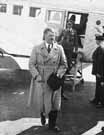
|
|
|

|

|

|

|
|
Click on an image to see a larger, more detailed picture.
|
|
|
|
|
| PROLOGUE: Roots of the Holocaust |

|
pg. 50 |

|
|
|
|
| |

|
 Hitler literally demonstrated his slogan "The Führer over Germany" as the first candidate to use an airplane during the 1932 presidential-election campaign.
Hitler literally demonstrated his slogan "The Führer over Germany" as the first candidate to use an airplane during the 1932 presidential-election campaign.
Photo: Ullstein Bilderdienst
|
|
During the winter of 1929-30, more than three million Germans (14 percent of the population) were jobless. By the autumn of 1932, five million were out of work, a figure that climbed to six million by January 1933. Unfortunately, the Weimar Republic's economic woes--industrial production fell 42 percent from 1929 to 1932--benefited the Nazis. Party membership doubled from 1928 to 1930. In September 1930 the Nazis won their first major breakthrough in Germany's national elections--nearly 6.4 million votes and 107 seats in the Reichstag, which made their delegation's size second only to the Social Democratic Party. The Nazi Party had more than 1.4 million members by the end of 1932. The reasons why Germans joined the Party or voted for Hitler were diverse. Party members and the Nazi electorate came from varied socioeconomic classes. Nazism attracted them because it took a strong stand against communism, or because other parties did not back their economic and political interests as the Nazis promised to do. Antisemitism played a part, too, although not the most decisive one. Hitler sensed when and how to stress "the Jewish question" and when and how to downplay it. Although Hitler had led the Nazi Party for more than ten years, he did not become a German citizen until mid-February 1932. At the time, the Nazis needed to field a candidate against the Weimar Republic's aging incumbent president, Field Marshal Paul von Hindenburg. Hitler, the only Nazi with a chance to win, had to be naturalized before he was eligible to run. In a Germany wracked by economic depression and increasing political chaos, Hitler campaigned "for freedom and bread," hoping that idealistic young people and a beleaguered lower middle class would bring him victory. Hindenburg, perceived by moderate Germans as the last bulwark between communism or Nazism, defeated Hitler by more than seven million votes. The splintering of the electorate, however, forced a runoff, since Hindenburg had not received a majority. The field marshal won the second contest, but not before Hitler had narrowed the margin by nearly 1.2 million votes.
|
|

|

|

|

|
 March 13, 1932: Hitler receives 11.3 million votes in the German presidential election.
March 13, 1932: Hitler receives 11.3 million votes in the German presidential election.
|
 April 10, 1932: In a run-off election for president of Germany, incumbent Paul von Hindenburg defeats Hitler.
April 10, 1932: In a run-off election for president of Germany, incumbent Paul von Hindenburg defeats Hitler.
|
 May 30, 1932: German Chancellor Heinrich Brüning resigns.
May 30, 1932: German Chancellor Heinrich Brüning resigns.
|
 June 1, 1932: Franz von Papen is appointed chancellor of Germany.
June 1, 1932: Franz von Papen is appointed chancellor of Germany.
|
 June 14, 1932: The German government lifts its ban on Nazi Storm Troopers.
June 14, 1932: The German government lifts its ban on Nazi Storm Troopers.
|
 June 30, 1932: A pro-Nazi American organization, Friends of the New Germany, is founded. The name will later be changed to Amerika-Deutscher Volksbund (German-American Bund).
June 30, 1932: A pro-Nazi American organization, Friends of the New Germany, is founded. The name will later be changed to Amerika-Deutscher Volksbund (German-American Bund).
|
 July 31, 1932: In elections for the Reichstag,the National Socialists receive 37.3 percent (13,750,000) of the total votes cast. The number of seats held by National Socialists increases to 230 (of 608).
July 31, 1932: In elections for the Reichstag,the National Socialists receive 37.3 percent (13,750,000) of the total votes cast. The number of seats held by National Socialists increases to 230 (of 608).
|
|
|
|
|
| PROLOGUE: Roots of the Holocaust |

|
pg. 50 |

|
|
The Holocaust Chronicle
© 2009 Publications International, Ltd.
|
|
